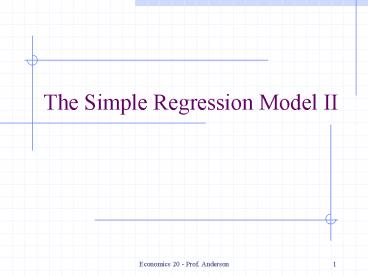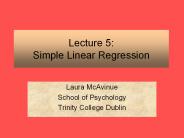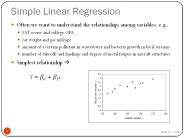The Simple Regression Model II - PowerPoint PPT Presentation
1 / 33
Title:
The Simple Regression Model II
Description:
Are they unbiased? What are the variances of the least squares estimators? Are they efficient? ... The OLS estimates of b1 and b0 are unbiased (see p. 51 for b0 proof) ... – PowerPoint PPT presentation
Number of Views:39
Avg rating:3.0/5.0
Title: The Simple Regression Model II
1
The Simple Regression Model II
2
Recap
- Two variable regression model
- y ß0 ß1x u or E(yx) ß0 ß1x
- Least squares estimation leads to
3
Recap (continued)
- The fitted regression line
- A residual
- A measure of goodness of fit
- R2 SSE/SST 1 SSR/SST
- where
4
Stata Output
- . regress wage educ
- Source SS df MS
Number of obs 526 - -------------------------------------------
F( 1, 524) 103.36 - Model 1179.73204 1 1179.73204
Prob gt F 0.0000 - Residual 5980.68225 524 11.4135158
R-squared 0.1648 - -------------------------------------------
Adj R-squared 0.1632 - Total 7160.41429 525 13.6388844
Root MSE 3.3784 - --------------------------------------------------
---------------------------- - wage Coef. Std. Err. t
Pgtt 95 Conf. Interval - -------------------------------------------------
---------------------------- - educ .5413593 .053248 10.17
0.000 .4367534 .6459651 - _cons -.9048516 .6849678 -1.32
0.187 -2.250472 .4407687 - --------------------------------------------------
---------------------------- - .
5
Lecture 4 Outline
- Consider functional form (or how to incorporate
some non-linearity). - Derive the sampling distribution of the least
squares estimators. - The sampling distribution is the basis of
- statistical inference
- evaluation of estimators.
6
Functional Form
- Fitted Linear wage equation model
- ?wage 0.541?educ
- One extra year of education leads to an
increased wage of 54 cents. - Constant change in wage whatever the level of
education.
7
Functional Form
- Suppose instead a constant percentage change in
the wage for a unit increase in education. - A model which captures this is
- log(wage) ß0 ß1educ u
- In this model
- ?wage ? (100.ß1)?educ
- Mathematically this is because
- log(1r) ? r for small r (Appendix A)
- It is more important, however, to understand the
practical implications.
8
Stata Example
- . use wage3, clear
- . generate logwagelog(wage)
- . regress logwage educ
- Source SS df MS
Number of obs 526 - -------------------------------------------
F( 1, 524) 119.58 - Model 27.5606288 1 27.5606288
Prob gt F 0.0000 - Residual 120.769123 524 .230475425
R-squared 0.1858 - -------------------------------------------
Adj R-squared 0.1843 - Total 148.329751 525 .28253286
Root MSE .48008 - --------------------------------------------------
---------------------------- - logwage Coef. Std. Err. t
Pgtt 95 Conf. Interval - -------------------------------------------------
---------------------------- - educ .0827444 .0075667 10.94
0.000 .0678796 .0976091 - _cons .5837727 .0973358 6.00
0.000 .3925563 .7749891 - --------------------------------------------------
----------------------------
9
Stata Example interpretation
- The fitted regression line is
- A one year increase in education leads to
(approximately) an 8.3 increase in the
(expected) wage. - This measures economists idea of the returns
to education. - The estimated intercept (0.584) is not
meaningful. - The R-squared value of 0.19 refers to variation
in log(wage).
10
A Constant Elasticity Model
- Consider the model
- log(y) ß0 ß1log(x) u
- Mathematically, ?y (ß1) ?x.
- In other words, ß1 is the constant elasticity of
y with respect to x.
11
Example
- Consider the model
- log(salary) ß0 ß1log(sales) u
- Estimating the model yields
n 209, R-squared 0.211. We estimate that a
1 increase in sales leads to a 0.26 increase in
CEO salary.
12
Other possibilities (e.g)
- y ß0 ß1log(x) u
- y ß0 ß1(1/x) u
- Many non-linear forms can be given a useful
linear representation. - Interpretation of estimated parameters depends on
precise functional form. - Choice should be based on views of underlying
data generation process (statistical tests,
convenience).
13
Sampling Distribution of OLS Estimators
- What are the expected values of the least
squares estimators? - Are they unbiased?
- What are the variances of the least squares
estimators? - Are they efficient?
- Do they have a normal distribution?
- How do we use this for statistical inference?
14
Unbiasedness of OLS
- Assume the population model is linear in
parameters as y b0 b1x u SLR.1 - Assume we can use a random sample of size n,
(xi, yi) i1, 2, , n, from the population
model. Thus yi b0 b1xi ui SLR.2 - Assume E(ux) 0 and thus E(uixi) 0 SLR.3
- Assume there is variation in the xi SLR.4
15
Unbiasedness of OLS (cont)
- In order to think about unbiasedness, we need to
rewrite our estimator in terms of the population
parameter - Start with a simple rewrite of the formula as
16
Unbiasedness of OLS (cont)
17
Unbiasedness of OLS (cont)
18
Unbiasedness of OLS (cont)
19
Unbiasedness Summary
- The OLS estimates of b1 and b0 are unbiased (see
p. 51 for b0 proof) - Proof of unbiasedness depends on our 4
assumptions if any assumption fails, then OLS
is not necessarily unbiased - Remember unbiasedness is a description of the
estimator in a given sample we may be near or
far from the true parameter
20
Variance of the OLS Estimators
- Now we know that the sampling distribution of
our estimator is centered around the true
parameter - Want to think about how spread out this
distribution is - Much easier to think about this variance under
an additional assumption, so - Assume Var(ux) s2 (Homoscedasticity)
21
Variance of OLS (cont)
- Var(ux) E(u2x)-E(ux)2
- E(ux) 0, so s2 E(u2x) E(u2) Var(u)
- Thus s2 is also the unconditional variance,
called the error variance - s, the square root of the error variance is
called the standard deviation of the error - Can say E(yx)b0 b1x and Var(yx) s2
22
Homoskedastic Case
y
f(yx)
.
E(yx) b0 b1x
.
x1
x2
23
Heteroskedastic Case
f(yx)
y
.
.
E(yx) b0 b1x
.
x
x1
x2
x3
24
Variance of OLS (cont)
25
Variance of OLS Summary
- The larger the error variance, s2, the larger
the variance of the slope estimate - The larger the variability in the xi, the
smaller the variance of the slope estimate - As a result, a larger sample size may decrease
the variance of the slope estimate - Problem that the error variance is unknown
26
Variance of OLS (cont.)
- There is a similar expression for the variance
of the intercept estimator
- There is a non-zero covariance between the slope
and intercept estimators
27
Normality
- To complete the derivation of the sampling
distribution we need to assume that - ux Normal(0, s2)
- Since the slope estimator is a linear function
of the us,
28
Inference?
- It would seem that
- could form the basis of statistical inference.
- However s is unobservable.
- Hence
29
Estimating the Error Variance
- We dont know what the error variance, s2, is,
because we dont observe the errors, ui - What we observe are the residuals, ûi
- We can use the residuals to form an estimate of
the error variance
30
Error Variance Estimate (cont)
31
Error Variance Estimate (cont)
32
Inference Again
does not have a normal distribution but
rather has a t-distribution with n-2 degrees of
freedom.
- The t-distribution
- has fatter tails than normal
- is characterised by degrees of freedom
- gets more like normal as df increase
33
Next Week
- Chapter 3 of Wooldridge
- Estimation of the multiple regression model
- y b0 b1x1 b2x2 bkxk u
- E(yx) b0 b1x1 b2x2 bkxk






























